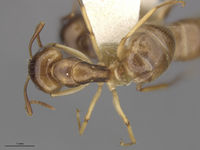Camponotus ramulorum vernulus
| Camponotus ramulorum vernulus | |
|---|---|

| |
| Scientific classification | |
| Kingdom: | Animalia |
| Phylum: | Arthropoda |
| Class: | Insecta |
| Order: | Hymenoptera |
| Family: | Formicidae |
| Subfamily: | Formicinae |
| Tribe: | Camponotini |
| Genus: | Camponotus |
| Species: | C. ramulorum |
| Subspecies: | C. ramulorum vernulus |
| Trinomial name | |
| Camponotus ramulorum vernulus Wheeler, W.M., 1936 | |
One of numerous endemic Hispaniola Camponotus species that we known very little about.
Identification
Distribution
Latitudinal Distribution Pattern
Latitudinal Range: 18.38° to 18.38°.
| North Temperate |
North Subtropical |
Tropical | South Subtropical |
South Temperate |
- Source: AntMaps
Distribution based on Regional Taxon Lists
Neotropical Region: Haiti (type locality).
Distribution based on AntMaps
Distribution based on AntWeb specimens
Check data from AntWeb
Countries Occupied
| Number of countries occupied by this species based on AntWiki Regional Taxon Lists. In general, fewer countries occupied indicates a narrower range, while more countries indicates a more widespread species. |

|
Estimated Abundance
| Relative abundance based on number of AntMaps records per species (this species within the purple bar). Fewer records (to the left) indicates a less abundant/encountered species while more records (to the right) indicates more abundant/encountered species. |

|
Biology
Castes
Worker
Minor
Nomenclature
The following information is derived from Barry Bolton's Online Catalogue of the Ants of the World.
- vernulus. Camponotus (Tanaemyrmex) ramulorum var. vernula Wheeler, W.M. 1936b: 206 (s.w.) HAITI.
- Type-material: 5 syntype major workers, 2 syntype minor workers.
- Type-locality: Haiti: NE foothills, Massif de la Hotte, 3000-4000 ft, 1934 (P.J. Darlington).
- Type-depository: MCZC.
- Subspecies of ramulorum: Kempf, 1972a: 71; Bolton, 1995b: 129; Lubertazzi, 2019: 89.
- Distribution: Haiti.
Unless otherwise noted the text for the remainder of this section is reported from the publication that includes the original description.
Description
Worker
Worker major. Length 4.5 -5 mm.
Smaller than the typical ramulorum from the Bahamas and differing in coloration. Mandibles and whole head, except the posterior corners, very dark brown, as are also the antennal scapes, except their bases. Thorax also darker brown above than in ramulorum, with the yellow maculae smaller; gaster paler brown, with yellow posterior borders to the segments but appearing much less distinctly fasciate than in the typical form of the species. Tibiae and knees reddish. The coarse punctures on the cheeks and clypeus are much more pronounced than in ramulorum and the occiput has a row of coarse, elongate punctures.
Worker minor. Length about 4 mm.
Also smaller than the worker of the typical ramulorum; head, mesonotum, mesopleurae and dorsal surface of gaster distinctly brown; antennae, knees and tarsi more reddish.
Type Locality Information
Described from five major and two minor workers taken by Dr. Darlington in the northeastern foot-hills of the Massif de la Hotte, Haiti, at an altitude of 3000-4000 ft.
References
- Lubertazzi, D. 2019. The ants of Hispaniola. Bulletin of the Museum of Comparative Zoology, 162(2), 59-210 (doi:10.3099/mcz-43.1).
- Wheeler, W. M. 1936c. Ants from Hispaniola and Mona Island. Bulletin of the Museum of Comparative Zoology 80: 195-211 (page 206, soldier, worker described)





